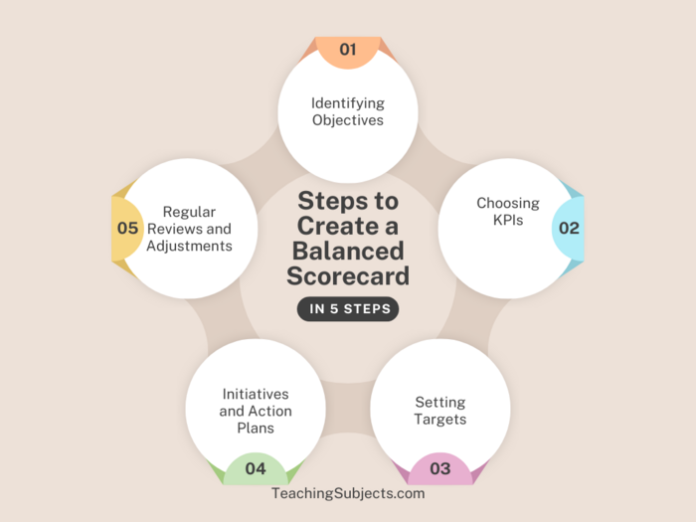Introduction
Performance measurement in business and management is crucial for ensuring organizations achieve their strategic objectives and continuously improve their operations. The Balanced Scorecard is a comprehensive strategic planning and management system among the various available tools. Developed by Robert Kaplan and David Norton, the Scorecard provides a framework that measures financial outcomes and includes operational metrics across four key perspectives: financial, customer, internal business processes, and learning and growth. This blog post aims to delve into the essence of the Balanced Scorecard, explaining what it is, how it’s used in different organizations, where it finds applications, and highlighting its relevance for college students preparing to enter the business world.
What is the Balanced Scorecard?
The Balanced Scorecard is a strategic planning and management system that organizations use to align business activities with the vision and strategy of the organization. It enhances internal and external communications and monitors organizational performance against strategic goals.
Robert Kaplan and David Norton introduced the concept of the Balanced Scorecard in the early 1990s. Their initial research, aimed at addressing the limitations of traditional financial metrics in measuring business performance, resulted in the creation of this comprehensive framework. Over the years, the Balanced Scorecard has evolved into a widely accepted tool, helping organizations across various industries execute their strategies effectively.
The Balanced Scorecard’s key components are its four perspectives: financial, customer, internal business processes, and learning and growth. The financial perspective focuses on traditional financial metrics like profit margins and return on investment. The customer perspective emphasizes customer satisfaction and retention. The internal business processes perspective looks at the efficiency and effectiveness of organizational processes. Finally, the learning and growth perspective concerns the organization’s ability to innovate and improve, ensuring long-term growth and development.
How is the Balanced Scorecard Used?
Strategic Planning
The Balanced Scorecard plays a pivotal role in strategic planning by aligning day-to-day work with the organization’s long-term strategy. It ensures that every department and employee’s efforts are directed towards achieving the overarching goals. The Scorecard helps prioritize projects and initiatives that contribute most effectively to vision attainment by providing a clear view of the organizational strategy. This alignment fosters a cohesive approach to strategy execution, reducing mismanagement and the risk of resource wastage.
Performance Measurement
Performance measurement is another crucial function of the Balanced Scorecard. It incorporates tracking key performance indicators (KPIs) to monitor progress toward strategic goals. By translating strategic objectives into measurable targets, the Balanced Scorecard allows organizations to gauge performance precisely and identify areas for improvement. This continuous monitoring process helps in timely corrective actions, ensuring the organization remains on the right path to achieving its strategic objectives.
Communication Tool
The Balanced Scorecard also serves as an effective communication tool within organizations. Sharing the strategy clearly across all levels ensures that everyone understands the strategic vision and their role in achieving it. This transparency fosters a culture of accountability and engagement, where employees feel connected to the organization’s strategic direction. Regular updates and reviews maintain this alignment, reinforcing the shared commitment to the organizational goals.
Examples of Implementation
Implementing the Balanced Scorecard can be seen across various sectors, providing insightful case studies. For instance, businesses like Hilton Hotels have utilized the Scorecard to improve customer satisfaction and operational efficiency. Non-profit organizations, such as the Boys and Girls Clubs of America, have applied it to align their activities with their mission and improve service delivery. In the government sector, agencies like the City of Charlotte have successfully employed the Balanced Scorecard to enhance performance management and accountability. These examples illustrate the versatility and effectiveness of the Balanced Scorecard in different organizational contexts.
Where is the Balanced Scorecard Used?
Sectors and Industries
Business corporations widely adopt the Balanced Scorecard to translate their strategic vision into actionable objectives. These organizations can maintain a competitive edge by focusing on comprehensive performance metrics beyond financial outcomes. Non-profit organizations benefit from the Balanced Scorecard by aligning their programs and activities with their mission, enhancing service delivery, and ensuring stakeholder accountability. The Balanced Scorecard is employed in government agencies to improve operational efficiency, transparency, and public service outcomes.
Global Usage
The Balanced Scorecard’s adoption spans various countries and cultures, demonstrating its global relevance and versatility. Its flexible framework makes it adaptable to different organizational contexts, allowing integration with local management practices and strategic priorities. As organizations increasingly operate in global environments, the Balanced Scorecard helps maintain a consistent strategic focus while accommodating diverse cultural and operational nuances. This adaptability ensures its effectiveness in driving performance and achieving strategic goals across many settings.
Integrating the Balanced Scorecard with Other Frameworks
Porter’s Five Forces framework is a powerful tool for examining the competitive forces that shape an industry and influence its profitability. Developed by Michael E. Porter in 1979, this model identifies five key sources of competitive pressure: the threat of new entrants, the bargaining power of suppliers, the bargaining power of buyers, the threat of substitute products or services, and the intensity of competitive rivalry. Understanding these forces allows organizations to assess their competitive environment and devise strategies that leverage strengths and mitigate threats. This analysis is vital for strategic decision-making as it highlights market dynamics and identifies areas for potential growth or risk.
Integrating the Balanced Scorecard with Porter’s Five Forces can create a comprehensive strategic plan that enhances organizational performance. While Porter’s model provides insights into the competitive landscape, the Balanced Scorecard translates these insights into actionable objectives aligned with strategic goals. For instance, an organization can use Porter’s Five Forces to identify competitive threats and implement corresponding performance metrics through the Balanced Scorecard to monitor progress. Additionally, other frameworks like SWOT analysis and PESTEL analysis can complement this approach by providing further context, helping organizations evaluate internal strengths and weaknesses and external political, economic, social, technological, environmental, and legal factors. By employing these complementary frameworks together, organizations can develop robust strategies that respond to market conditions and drive sustainable growth.
Steps to Create a Balanced Scorecard
- Identifying Objectives: Set clear goals aligned with the organization’s mission and vision. These objectives should provide a roadmap for achieving strategic priorities across all areas of the organization.
- Choosing KPIs: Select relevant Key Performance Indicators (KPIs) for each perspective of the Balanced Scorecard. These indicators will help assess progress toward the strategic objectives and provide measurable insights.
- Setting Targets: Establish achievable and measurable targets for each KPI. Targets should be specific, realistic, and time-bound, ensuring that they drive performance while being attainable within the set timeframe.
- Initiatives and Action Plans: Plan and implement initiatives to achieve the established targets. These action plans should outline the necessary steps, resources, and timelines for execution, ensuring accountability and clarity in execution.
- Regular Reviews and Adjustments: Monitor performance regularly through scheduled reviews. This process involves analyzing KPI results, making necessary adjustments to strategies and initiatives, and ensuring that the organization remains responsive to changing conditions and aligned with its strategic objectives.
Conclusion
In summary, the Balanced Scorecard is an invaluable tool in strategic management, allowing organizations to transform their vision and strategy into a cohesive set of performance measures. Its comprehensive approach ensures that all aspects of an organization’s performance are considered, promoting alignment and accountability in achieving strategic objectives. As you explore academic and professional avenues, we encourage you to delve into the principles of the Balanced Scorecard and consider its application within your context. Your insights and experiences are vital to this discussion, so please feel free to leave comments or questions as we continue to engage on this essential topic.
















